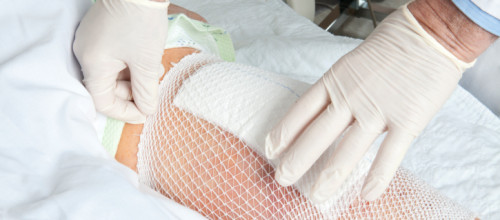
Knee Pain – Why Your Knee Hurts
The knee is the most commonly replaced joint in the body. It is also one of the most difficult decisions to make when deciding whether or not you wish to have total knee replacement or deal with the pain. In this blog post we will talk about common knee ailments, figure out why your knee hurt, and shed light on the topic of total knee replacement. The decision will be made based on your age, physical fitness level, pain severity, and other factors.
Common Types of Knee Pain
You may be wondering why your knee hurts, what causes your pain, and how to cure it. There are several common causes for knee pain. The first is arthritis, which is inflammation and stiffness of the joints. This can occur due to age or over use. Another cause of pain is tendinitis, which is inflammation of a tendon – the part of a join that attaches muscle to bones. This occurs from overuse or repetitive motions. The last is what is called Osteoarthritis, which is degenerative joint disease which cause the degradation of joints. Therapy can be used to solve this pain, and in some cases joint replacement is necessary.
Need for Total Knee Replacement
Typically, Total Knee replacement, also known as TKR happens when the following situations arise. If you suffer from joint damage due to osteoarthritis, rheumatoid arthritis, bone disease, or fractures, you might consider total knee replacement. Additionally, pain or alignment issues in your leg that make walking or daily life task too difficult may be another indication of the need for total knee replacement.
What is Total Knee Replacement?
As defined by Move Forward Physical Therapy, Total Knee Replacement can be defined as, “removing the ends of the bones at the knee joint (the tibia, sometimes called “shin bone”) and the femur (thigh bone) and replacing them with artificial parts. Replacement parts consist of a metal cap placed on the end of the femur and a plastic cap placed on the top of the shin bone. Sometimes, a plastic insert is used to replace the kneecap.”
Treatment Before and After TKR
The better your condition before surgery the better your results will be post-surgery. Before you get your surgery, a good PT will teach you exercises and show you how to walk with assistance after your operation. They will also discuss precautions and adaptations to your life after surgery, such as removing rugs and avoiding slippery surfaces.
After surgery your physical therapist will show you how to walk with crutches, show you how o get up and out of bed or chairs, and help o strengthen your joints and muscles to increase flexibility. As you begin to recover slowly, your Physical therapist will help you by providing a focus in 5 areas. They are range of motion exercises, strengthening exercises, body awareness and balance, functional training, and activity specific training.
We hope that your knee pain will eventually subside, but if you have been feeling pain for a prolonged time period it may be the right moment to get evaluated. Our experienced staff would be more than happy to help you on your way to recovery, whether it is just a minor common knee pain, or the need for a TKR, Physical Solutions will be there for you the whole way.
